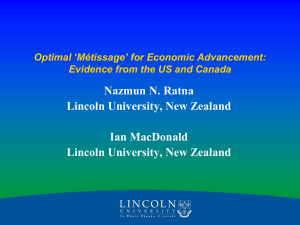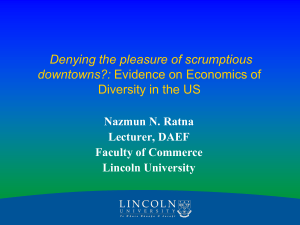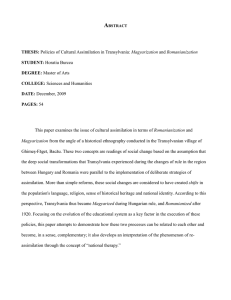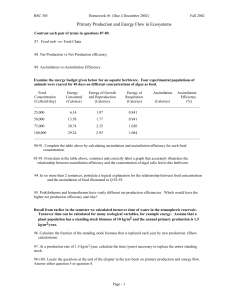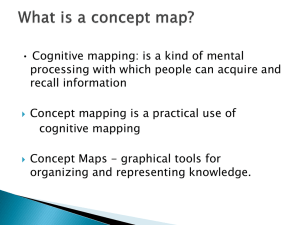Economic Assimilation Immigrant Workers: Evidence from cities in the USA
advertisement
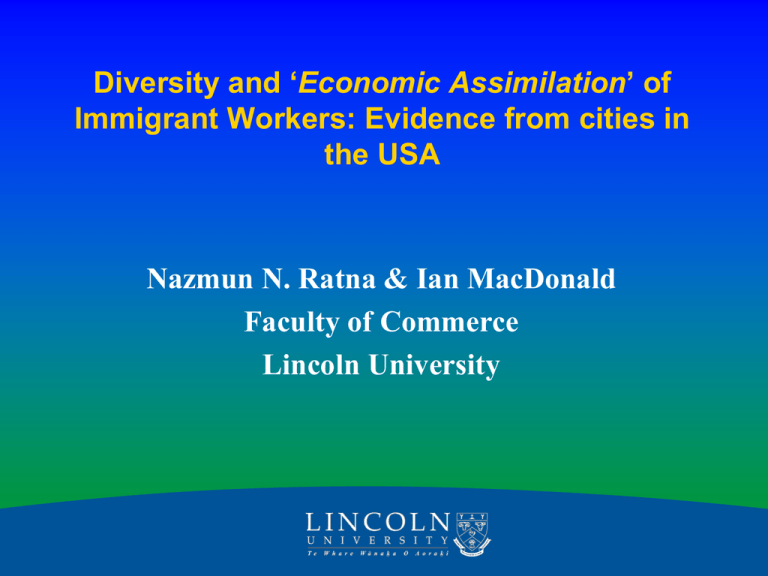
Diversity and ‘Economic Assimilation’ of Immigrant Workers: Evidence from cities in the USA Nazmun N. Ratna & Ian MacDonald Faculty of Commerce Lincoln University Motivation • • • • Is diversity good for economic growth? Do settler societies experience productivity gains (or losses) from diversity? What are the economic consequence of increasing diversity on native workers in settler societies? Do foreign-born workers assimilate economically i.e. the wages of foreign-born workers approach those of ‘observationally equivalent’ native workers? What should policies opt for: cultural or economic assimilation? Does the rate of economic assimilation depend on social identities? Diversity and economic outcomes • Conflict of preferences and provision of public goods (Easterly and Levine 1997, Alesina et. al. 1999) • Diversity, and interpersonal trust (Knack and Keefer 1997, Zak and Knack 2001, Collier and Gunning 1999, Alesina and Ferrera 2002, Putnam 2000) • Diversity and social divergence (Grafton, Knowles and Owen 2004, Grafton, Kompas and Owen 2007, Ratna, Grafton and Kompas 2009) Immigration and labour market outcomes • Impact of immigrantion on competing native workers: Borjas (1994, 1995, 1999, 2001, 2003), Card (1990, 2001) • Economic value of cultural diversity (Ottaviano & Peri 2003) • Linguistic diversity, wages and employment diversity on native workers (Ottaviano & Peri 2005) Diversity, Knowledge interactions & Barriers to communication Barriers to communication created through differences in language, ethnicity or religion, deter the ‘cross-fertilization’ of ideas and knowledge due to lower social interactions across the groups and, hence, have negative impact on productivity (Grafton, Kompas and Owen 2007) , Diversity and Wages: City level analysis • Empirical model ln( wc ,t ) = χ c + β t + δ c (c c ,t ) + α d (d c ,t ) + ec ,t • Measuring Diversity n FRACi = 1- ∑ j f ji2 Diversity and Labour Productivity ln ( average wage of all workers: 15 -64 yrs) (i) (ii) (iii) (iv) Race -.358*** -.409*** -.513*** -.210*** Language .735*** -.041 .165 -.233 Culture 2.138*** 2.137*** 2.186*** 1.912*** Education .612** .725** .767*** .728** LI -.532** -0.876** -.891*** Language*LI 2.216** 3.573*** 1.909*** Years FE Yes Yes Yes Yes City FE Yes Yes Yes Yes Dependent Variable ln (Wage of white workers: 15 -64) (i) (ii) Race -.446*** -.656*** Language .914*** .103 Culture 2.209*** 2.311*** Education .408* .758** LI -1.445*** Lang*LI 5.149*** Years FE Yes Yes City FE Yes Yes IVE change in ln (Wage) change in ln (Wage_WW) -1.81*** .743 9.529*** 9.623*** Endogeniety and IVE • Instruments for diversity index • Shift-share technology ( Card 2001, Ottaviano and Peri 2003, 2005) c (xi ) 2000 = ( x c )1980 [1 + ( g i ) 80 − 00 ] i ∑ ( x i ) 2000 c Shift –Share Diversity= 1- i Economic Assimilation of non-native workers • Non-native/foreign-born/ immigrant workers • Wage convergence from below toward the higher native mean ( Kim 2009) • The rate at which the gap between earnings of native and immigrants narrows, is interpreted as a measure of economic assimilation ( Meng & Gregory 2002) Concluding Remarks • Diversity by itself is not the problem, but barriers to communication across social groups (racial in our estimates) and the consequent social isolation have negative social & economic outcomes. Thus policies that promote ‘bridging’ likely to have not only social or political, but substantial economic payoffs as well. Concluding Remarks • Policy Implications : Economic Assimilation and Cultural Integration – Language and skill training – Education policy • When barriers to communication are nonexistent /less prevalent, immigration enhances economic growth
